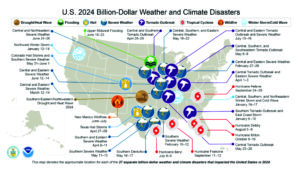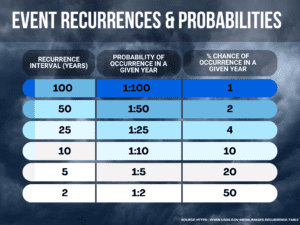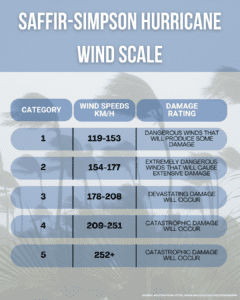How Stress Release Clip Systems Help Wind Fences Withstand 100-Year Storms and Extreme Weather
Contents
- Mother Nature’s Fury: One Hundred Year Storms
- Mesh, Might and Mastery: Custom Wind Fence Basics
- Storm Shield: The Release Clip Solution
- Peace of Mind: Parting Thoughts
Weather around the world is rapidly changing in a catastrophic manner. Storms and climate disasters are increasing in intensity and severity each year leaving a trail of death and destruction in their wake. Recently, The National Centers for Environmental Information released their findings for 2024 highlighting the 27 weather or climate related disaster events with losses in excess of $1B in the United States alone1. Losses occurring from these events and others around the world are estimated to exceed $133B USD2. In the last five years, the annual average of these events in the US is documented to be 23, well over double the annual average of 9 from 1980 – 20241 With the current state of affairs in the world, it seems likely that these trends will continue and we will likely experience more severe weather with increasing collateral damage. Industries and businesses alike need to take action and brace for impact.

Source: https://www.ncei.noaa.gov/access/billions/
You might be wondering what all of this talk about severe storms has to do with custom wind fences. The answer is that wind fences are often situated on industrial or agricultural sites that are geographically located in areas prone to large storms and wind events. Wind fences can catastrophically fail or suffer irreparable damage during these events unless they are equipped with a stress release system such as those developed and designed by the experts at WeatherSolve Structures. This blog will explore why a stress release system is absolutely essential for wind fences, especially those located in high-risk areas.
1. Mother Nature’s Fury: One Hundred Year Storms
We have all seen and heard the term “one-hundred-year storm” popping up on television and in our social media feeds. But what exactly IS a 1:100-year storm? Simply put, a 1:100-year storm is a massive storm event that has a 1% chance of occurring in a given year, in other words, a 1 in 100 chance3. The statistical designation of 1:100 is based on interpretation and analysis of historical data and an estimated probability of a storm event occurring: its recurrence interval. Think of it as a game of chance: You place numbers from 1 to 100 in a hat, give it a good shake and pull out a number. If you pull the number 100 out then a 1:100-year storm will occur.
The wording of “one-hundred-year storm” should not be taken literally. A 1:100-year storm is often misinterpreted as being guaranteed to happen every 100 years whereas in reality, there is actually a 63% probability of it occurring in that time frame4. In addition, although extremely unlikely, there is also the possibility of more than one 1:100-year storm in a given year4. You may be really lucky, or in this case very unlucky and pull that “100” out of the hat more than once, right?!

Wind speeds, tidal surges and rainfall levels seen with a 1:100-year storm will vary dependent on the location and specific weather conditions. In the case of a Category 5 hurricane, wind speeds can reach upwards of 200km/h causing total roof collapses and rendering those areas hit uninhabitable for months5. The image below provides information on wind speeds during various storm categories.

2. Mesh, Might and Mastery: Custom Wind Fence Basics
Before we jump into stress release clip systems for custom wind fences, let’s recap the basics on wind fences. A wind fence is an engineered porous barrier erected to alter wind patterns and mitigate dust dispersion. By disrupting wind flow, these fences can decrease wind speeds by up to 80% in localized areas and 50% over larger expanses. A fence that is placed relatively perpendicular windward to the protected area is referred to as an upwind fence. An upwind fence redirects the wind up and over the fence while allowing a small amount of air to still pass through the fence. This usually creates a sheltered zone on the leeward side of the fence that extends for 8 to 10 times the height of the fence. The sheltered zone has significantly reduced wind velocity which allows dust to settle quickly. The small amount of air that passes through the fence equalizes the differential pressure and minimizes the formation of turbulence and wind eddies that are commonly seen with the erection of a solid wall. Conversely, when a wind fence is placed relatively perpendicular to outgoing winds, it is referred to as a downwind fence. A downwind fence acts as a catch fence and has a small sheltered area in front of the fence that allows dust particles to drop out of the air and collect. A small amount of the dust will still pass through the fence, but quickly falls to the ground in the protected zone on the leeward side of the fence, just as with the upwind fence. As wind directions change, an upwind fence may function as a downwind fence and a downwind fence may function as an upwind fence.
3. Storm Shield: The Release Clip Solution
Not all custom wind fences are created equally. When Mother Nature strikes with a hundred-year storm wind speeds range from 100 – 250 km/h dependent on the storm category5 and many fences suffer complete failure or irreparable damage. Without the integration of a stress release clip system to alleviate the tremendous pressure on wind fence panels during a catastrophic storm, these fence structures may experience large amounts of panel failure, topple or are completely obliterated.

With over 40 years of experience designing, developing and erecting environmental control structures, WeatherSolve Structures leads the way for storm resistant structures with their proprietary stress release clip system. The clips are composed from nylon and spaced at predetermined spacings along the top and bottom of the wind fence panel. The spacing is determined based on the required strength and design speed requirements for the fence. The design wind speed is typically for a 1 in 50 return gust and nylon clips are spaced to allow failure on the lower edge of the panel at approximately a 1 in 20 wind. During normal operation and usual wind speeds the fence carries on as is with all clips in place. Any shock loads from usual weather are absorbed by the yarns in the fabric which transfer the load up through the clips to the cable and ultimately the structural poles. When the panels are experiencing approximately 30% overload pressures due to excessive winds or storms, the proprietary stress release clips on the bottom of the panel operate much like a zipper and release allowing the bottom hem cable to bow out with the wind and release approximately 30% of the load from the panel. Once the wind event or storm is over, lower clips are easily replaced, and the wind fence is up and running in a short time.
In extreme storms such as a 1:100-year storm causing greater than 30% overload on the panel, the lower hem cable breaks free and the fabric pulls out of the proprietary lockstrips mounted on the poles. The upper clips remain secure allowing the panel to flap in the wind until the storm subsides. In this extreme case, some panels may rip and require replacement but the structural integrity of the fence remains intact. In keeping with their commitment to quality and ongoing advancement the proprietary stress release clips are assessed after each major storm that occurs on a WeatherSolve Structure. This allows for an individual assessment to confirm expected outcomes or presents an opportunity to tweak current designs to enhance performance.
4. Peace of Mind: Parting Thoughts
The increasing frequency and severity of extreme weather events emphasizes the need for industries and businesses to adopt resilient infrastructure, particularly in areas prone to wind events and storms. As climate change continues to alter global weather patterns for the worse, catastrophic storms such as 1:100-year events will become more common place. Custom wind fences are crucial for managing wind and dust and must be designed to withstand these intensifying weather patterns. WeatherSolve’s innovative stress release clip system offers a vital solution, ensuring that wind fences can endure extreme forces without incurring structural failure or irreparable damage. This technology allows companies to protect their wind fence investment, minimize damage and maintain operational continuity in the face of unpredictable weather events. It is clear that the integration of stress release clip systems into wind fence design is not just beneficial, but critical in today’s rapidly changing climate.
References & Reading Material:
1. NOAA National Centers for Environmental Information (NCEI) U.S. Billion-Dollar Weather and Climate Disasters (2025) https://www.ncei.noaa.gov/access/billions/,
DOI: 10.25921/stkw-7w73 Accessed January 28, 2025
2. Munich RE 2024 tropical cyclone season leaves above-average losses in its wake https://www.munichre.com/en/insights/natural-disaster-and-climate-
change/summary-of-the-2024-hurricane-season.item-bcba19332b4e92464a7033c87cb7d738.html Accessed January 28, 2025
3. Wikipedia 100-year flood https://en.wikipedia.org/wiki/100-year_flood Accessed January 29, 2025
4. University of Wisconsin – Madison “The Weather Guys – What is a 100-year storm?” https://wxguys.ssec.wisc.edu/2018/08/28/100yr-storm/ August 28, 2018.
Accessed January 29, 2025.
5. NOAA National Centers for Environmental Information (NCEI) Saffir-Simpson Hurricane Wind Scale. https://www.nhc.noaa.gov/aboutsshws.php. Accessed
January 29, 2025

Claire Cowie is a seasoned Quality Assurance Manager with over two decades of experience in healthcare and manufacturing. Her career began in pharmacy, where she led teams and honed her skills in quality management systems. As she transitioned to the manufacturing sector, her unique background combines a deep understanding of policy and quality assurance with a keen eye for quality control.
Claire has been instrumental in implementing and cultivating a comprehensive quality control program within WeatherSolve Structures. She has successfully integrated her pharmaceutical background with manufacturing best practices, particularly in areas such as Good Manufacturing Practices (GMP) and ISO 9001 standards. Her unique blend of experience continues to drive innovation and excellence in her role.
